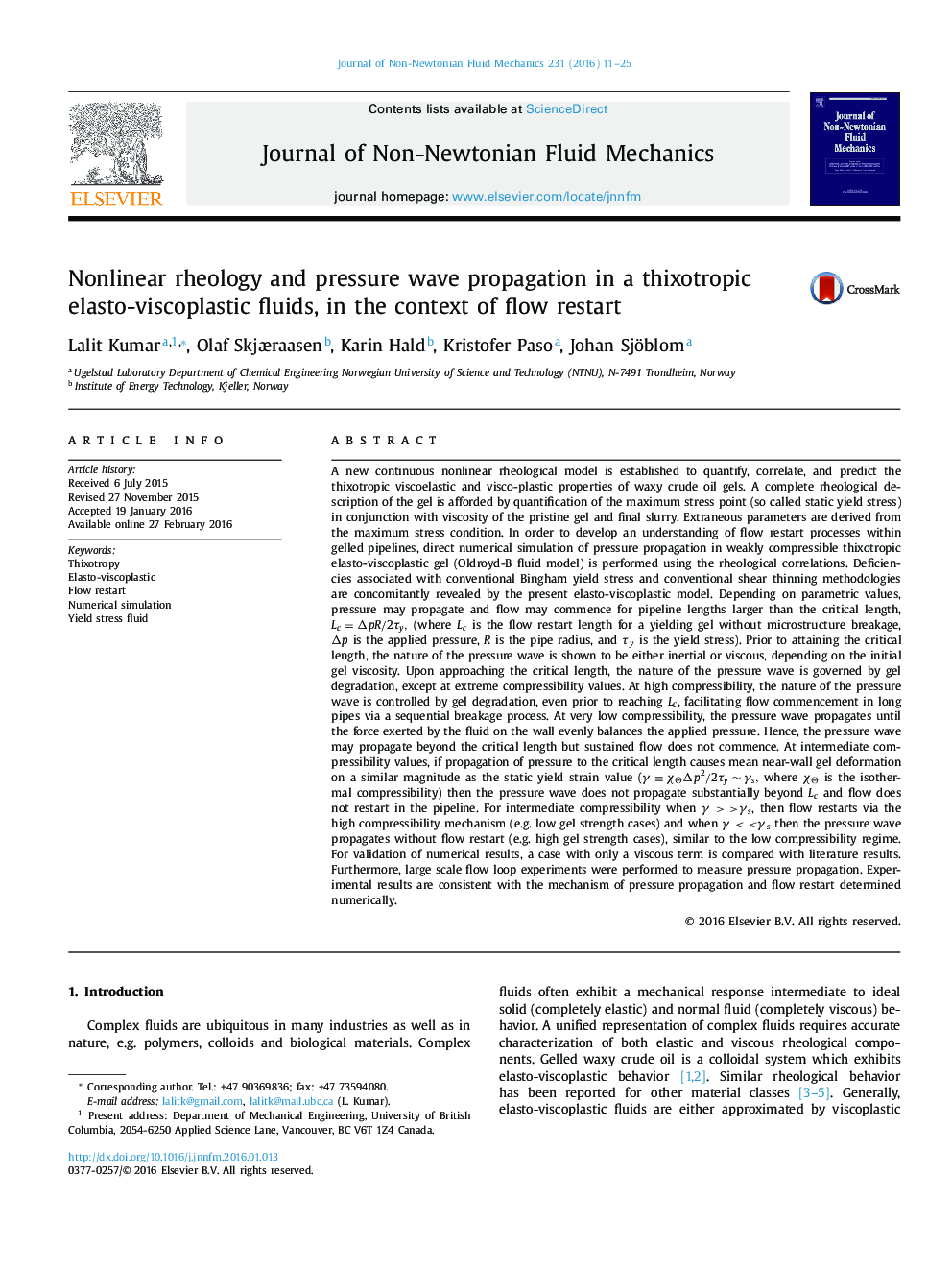| کد مقاله | کد نشریه | سال انتشار | مقاله انگلیسی | نسخه تمام متن |
|---|---|---|---|---|
| 7061212 | 1459009 | 2016 | 15 صفحه PDF | دانلود رایگان |
عنوان انگلیسی مقاله ISI
Nonlinear rheology and pressure wave propagation in a thixotropic elasto-viscoplastic fluids, in the context of flow restart
دانلود مقاله + سفارش ترجمه
دانلود مقاله ISI انگلیسی
رایگان برای ایرانیان
کلمات کلیدی
موضوعات مرتبط
مهندسی و علوم پایه
مهندسی شیمی
جریان سیال و فرایندهای انتقال
پیش نمایش صفحه اول مقاله

چکیده انگلیسی
A new continuous nonlinear rheological model is established to quantify, correlate, and predict the thixotropic viscoelastic and visco-plastic properties of waxy crude oil gels. A complete rheological description of the gel is afforded by quantification of the maximum stress point (so called static yield stress) in conjunction with viscosity of the pristine gel and final slurry. Extraneous parameters are derived from the maximum stress condition. In order to develop an understanding of flow restart processes within gelled pipelines, direct numerical simulation of pressure propagation in weakly compressible thixotropic elasto-viscoplastic gel (Oldroyd-B fluid model) is performed using the rheological correlations. Deficiencies associated with conventional Bingham yield stress and conventional shear thinning methodologies are concomitantly revealed by the present elasto-viscoplastic model. Depending on parametric values, pressure may propagate and flow may commence for pipeline lengths larger than the critical length, Lc=ÎpR/2Ïy, (where Lc is the flow restart length for a yielding gel without microstructure breakage, Îp is the applied pressure, R is the pipe radius, and Ïy is the yield stress). Prior to attaining the critical length, the nature of the pressure wave is shown to be either inertial or viscous, depending on the initial gel viscosity. Upon approaching the critical length, the nature of the pressure wave is governed by gel degradation, except at extreme compressibility values. At high compressibility, the nature of the pressure wave is controlled by gel degradation, even prior to reaching Lc, facilitating flow commencement in long pipes via a sequential breakage process. At very low compressibility, the pressure wave propagates until the force exerted by the fluid on the wall evenly balances the applied pressure. Hence, the pressure wave may propagate beyond the critical length but sustained flow does not commence. At intermediate compressibility values, if propagation of pressure to the critical length causes mean near-wall gel deformation on a similar magnitude as the static yield strain value (γâ¡ÏÎÎp2/2Ïyâ¼Î³s, where ÏÎ is the isothermal compressibility) then the pressure wave does not propagate substantially beyond Lc and flow does not restart in the pipeline. For intermediate compressibility when γ > >γs, then flow restarts via the high compressibility mechanism (e.g. low gel strength cases) and when γ < <γs then the pressure wave propagates without flow restart (e.g. high gel strength cases), similar to the low compressibility regime. For validation of numerical results, a case with only a viscous term is compared with literature results. Furthermore, large scale flow loop experiments were performed to measure pressure propagation. Experimental results are consistent with the mechanism of pressure propagation and flow restart determined numerically.
ناشر
Database: Elsevier - ScienceDirect (ساینس دایرکت)
Journal: Journal of Non-Newtonian Fluid Mechanics - Volume 231, May 2016, Pages 11-25
Journal: Journal of Non-Newtonian Fluid Mechanics - Volume 231, May 2016, Pages 11-25
نویسندگان
Lalit Kumar, Olaf Skjæraasen, Karin Hald, Kristofer Paso, Johan Sjöblom,